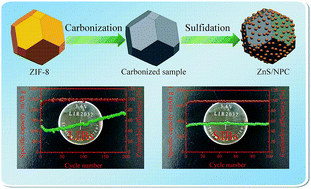当前位置:
X-MOL 学术
›
J. Mater. Chem. A
›
论文详情
Our official English website, www.x-mol.net, welcomes your feedback! (Note: you will need to create a separate account there.)
ZnS nanoparticles decorated on nitrogen-doped porous carbon polyhedra: a promising anode material for lithium-ion and sodium-ion batteries
Journal of Materials Chemistry A ( IF 11.9 ) Pub Date : 2017-09-05 00:00:00 , DOI: 10.1039/c7ta06180c Jiabao Li 1, 2, 3, 4, 5 , Dong Yan 1, 2, 3, 4, 5 , Xiaojie Zhang 1, 2, 3, 4, 5 , Shujin Hou 1, 2, 3, 4, 5 , Ting Lu 1, 2, 3, 4, 5 , Yefeng Yao 1, 2, 3, 4, 5 , Likun Pan 1, 2, 3, 4, 5
Journal of Materials Chemistry A ( IF 11.9 ) Pub Date : 2017-09-05 00:00:00 , DOI: 10.1039/c7ta06180c Jiabao Li 1, 2, 3, 4, 5 , Dong Yan 1, 2, 3, 4, 5 , Xiaojie Zhang 1, 2, 3, 4, 5 , Shujin Hou 1, 2, 3, 4, 5 , Ting Lu 1, 2, 3, 4, 5 , Yefeng Yao 1, 2, 3, 4, 5 , Likun Pan 1, 2, 3, 4, 5
Affiliation

|
Rational fabrication and structure design of anode materials with high specific capacity and excellent cycling stability are of significant importance for the development of high-performance lithium-ion batteries (LIBs) and sodium-ion batteries (SIBs). In this paper, a zeolitic imidazolate framework-8 (ZIF-8) with a unique polyhedral morphology and large size (about 2 μm) was successfully synthesized through a facile co-precipitation method. After successive carbonization and sulfidation, ZnS nanoparticles decorated on nitrogen-doped porous carbon polyhedra (ZnS/NPC) were obtained. When applied as the anode material for LIBs, the ZnS/NPC hybrid displays the highest reversible specific capacity for ZnS-based electrodes reported so far (1067.4 mA h g−1 at 0.1 A g−1 after 200 cycles), excellent rate capability (364.6 mA h g−1 at 4 A g−1), and robust long-term cycling performance (856.8 mA h g−1 at 1 A g−1 after 1000 cycles). As for SIBs, the resultant ZnS/NPC also exhibits a desirable capacity of 370.6 mA h g−1 after 100 cycles at 0.1 A g−1 and 289.2 mA h g−1 after 1000 cycles at 1 A g−1. Such superior lithium and sodium storage performances should be attributed to the distinctive structure advantages inherited from ZIF-8, where the Zn ions were in situ converted to ZnS with high reactivity upon electrochemical cycling and the organic linkers were pyrolyzed to nitrogen-doped porous carbon polyhedra to enhance the conductivity of the hybrid and keep the structure stability during cycling.
中文翻译:

氮掺杂的多孔碳多面体上装饰的ZnS纳米颗粒:一种有前景的锂离子和钠离子电池负极材料
具有高比容量和出色循环稳定性的负极材料的合理制造和结构设计对于高性能锂离子电池(LIB)和钠离子电池(SIB)的开发至关重要。本文通过一种简便的共沉淀方法成功地合成了具有独特的多面体形态和大尺寸(约2μm)的沸石咪唑酸酯骨架8(ZIF-8)。经过连续的碳化和硫化后,获得了在氮掺杂的多孔碳多面体(ZnS / NPC)上装饰的ZnS纳米颗粒。当用作LIBS阳极材料施加时,硫化锌/ NPC混合显示用于基于硫化锌电极最高可逆比容量报告到目前为止(1067.4毫安汞柱-1在0.1 A克-1后200个循环),优良的速率能力(364.6毫安汞柱-1在4 A G -1),和健壮长期循环性能(856.8毫安汞柱-1 1个A G -1 1000次循环后)。对于SIB,所得的ZnS / NPC在0.1 A g -1的100个循环后还表现出370.6 mA hg -1的理想容量,在1 A g -1的1000循环后表现出289.2 mA hg -1的理想容量。如此优异的锂和钠储存性能应归因于ZIF-8所继承的独特结构优势,其中Zn离子就地存在 在电化学循环过程中以高反应性将其转化为ZnS,并将有机连接基热解为氮掺杂的多孔碳多面体,以增强杂化物的电导率并在循环过程中保持结构稳定性。
更新日期:2017-09-21
中文翻译:

氮掺杂的多孔碳多面体上装饰的ZnS纳米颗粒:一种有前景的锂离子和钠离子电池负极材料
具有高比容量和出色循环稳定性的负极材料的合理制造和结构设计对于高性能锂离子电池(LIB)和钠离子电池(SIB)的开发至关重要。本文通过一种简便的共沉淀方法成功地合成了具有独特的多面体形态和大尺寸(约2μm)的沸石咪唑酸酯骨架8(ZIF-8)。经过连续的碳化和硫化后,获得了在氮掺杂的多孔碳多面体(ZnS / NPC)上装饰的ZnS纳米颗粒。当用作LIBS阳极材料施加时,硫化锌/ NPC混合显示用于基于硫化锌电极最高可逆比容量报告到目前为止(1067.4毫安汞柱-1在0.1 A克-1后200个循环),优良的速率能力(364.6毫安汞柱-1在4 A G -1),和健壮长期循环性能(856.8毫安汞柱-1 1个A G -1 1000次循环后)。对于SIB,所得的ZnS / NPC在0.1 A g -1的100个循环后还表现出370.6 mA hg -1的理想容量,在1 A g -1的1000循环后表现出289.2 mA hg -1的理想容量。如此优异的锂和钠储存性能应归因于ZIF-8所继承的独特结构优势,其中Zn离子就地存在 在电化学循环过程中以高反应性将其转化为ZnS,并将有机连接基热解为氮掺杂的多孔碳多面体,以增强杂化物的电导率并在循环过程中保持结构稳定性。



























 京公网安备 11010802027423号
京公网安备 11010802027423号